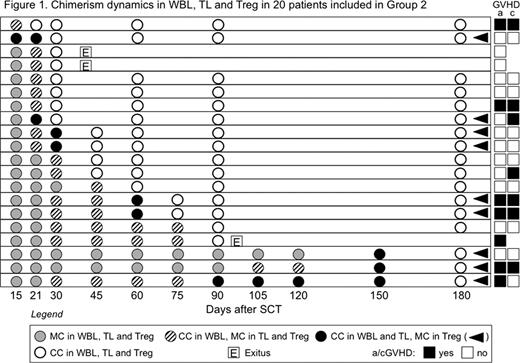Abstract
Abstract 1328
CD4+CD25+ regulatory T-cells (Treg) play an important role in inducing and maintaining allogeneic tolerance and can inhibit graft-versus-host disease (GVHD) after allogeneic stem cell transplantation (SCT). However, the dynamics of donor and recipient Treg cell populations after Allo-SCT has not been studied yet.
To analyze the dynamics of chimerism in Tregs and compare it to that of T lymphocytes (TL; CD3+) and whole blood leukocytes (WBL).
The study includes 53 patients subjected to Allo-SCT (myeloablative and non-myeloablative). PB samples were obtained weekly during the first month and every 14 days after day +30 until complete chimerism (CC) was achieved, and at fixed time-points (+30, +60, +90, +180, +365) thereafter. TL and Tregs were purified from PB until CC was achieved using inmunomagnetic technology (Miltenyi Biotec; CD3+ Microbeads and CD4+/CD25+ Treg Isolation Kit, respectively). Chimerism analysis was performed by microsatellite PCR (STR-PCR; AmpFlSTR SGM Plus; Applied Biosystems) on genomic DNA obtained from WBL as well as on cell lysates obtained from purified TL and Tregs. Complete chimerism was considered in samples with percentage of recipient cells <1% (sensitivity of the STR-PCR) for WBL samples and <5% (minimum purity of 95% as estimated by flow cytometry) for purified cell lineages.
Median follow up for the whole cohort of patients was 338 days. CC was spontaneously achieved in WBL, TL and Tregs in 45/53 patients (85%) in a median time of 35.41, 38.8 and 42.5 days respectively. 5/3 patients (9%) suffered from graft failure/rejection showing mixed chimerism (MC) with increasing percentages of recipient cells both in WBL and leukocyte lineages. 3/53 patients (6%) maintained mixed chimerism (MC) in WBL and leukocyte lineages at day +180, with no signs of graft rejection or disease relapse. Analysis of the chimerism dynamics of those patients who spontaneously achieve CC revealed two different groups: Group 1 included 25/45 patients who achieved CC at the same time in WBL, TL and Tregs. Group 2 included 20/45 patients who achieved CC in WBL while maintaining MC in TL and Tregs. Interestingly enough, 9/20 patients from Group 2 maintained MC in Tregs 7–75 days after achieving CC in both WBL and TL (Figure 1). In a preliminary analysis, the small sample size precluded from obtaining statistically significant associations between the dynamics of chimerism in Tregs and the development of complications such as relapse or GVHD after SCT.
To our knowledge, this is the first study dealing with Treg chimerism after SCT. We have shown it is feasible and can be performed on a routine basis together with standard lineage specific chimerism follow up. Although there is an association between chimerism dynamics in Tregs and TL, this is not absolute and a percentage of patients maintain residual Tregs of recipient origin after WTL and TL have become of complete donor origin. In this small cohort, Treg chimerism did not influence the development of post-SCT complications. Analysis of a larger and more homogeneous cohort would allow establishing the usefulness of Treg chimerism testing for the management of transplanted patients.
No relevant conflicts of interest to declare.
Author notes
Asterisk with author names denotes non-ASH members.


This feature is available to Subscribers Only
Sign In or Create an Account Close Modal